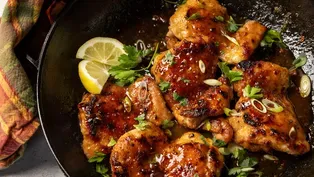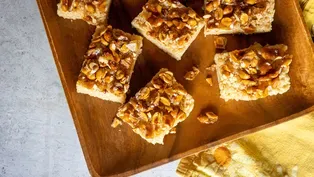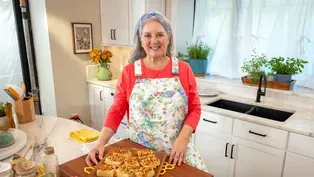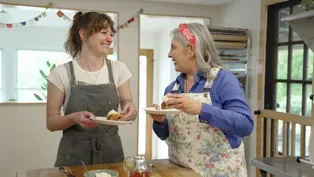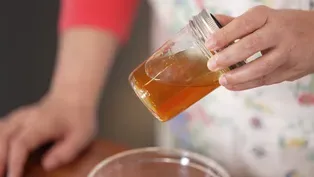
Field Trip with Beekeeper Mary Garrison
Clip: 10/21/2024 | 6m 5sVideo has Closed Captions
Sheri Castle dons a bee suit with beekeeper Mary Garrison to learn why the pollinators are vital.
Sheri Castle dons a bee suit with beekeeper Mary Garrison to learn why the pollinators are vital for more than just the sweet ingredient.

Field Trip with Beekeeper Mary Garrison
Clip: 10/21/2024 | 6m 5sVideo has Closed Captions
Sheri Castle dons a bee suit with beekeeper Mary Garrison to learn why the pollinators are vital for more than just the sweet ingredient.
How to Watch The Key Ingredient
The Key Ingredient is available to stream on pbs.org and the free PBS App, available on iPhone, Apple TV, Android TV, Android smartphones, Amazon Fire TV, Amazon Fire Tablet, Roku, Samsung Smart TV, and Vizio.
Providing Support for PBS.org
Learn Moreabout PBS online sponsorship[light upbeat music] Mary Garrison is a honeybee keeper who wants us to understand and treasure the vital role that bees play in nature, gardening, and farming.
Today, she's introducing me to some of those brilliant busy bees, and then we sit down in her cozy kitchen for a delicious lesson in tasting honey from around the world.
Mary, I've made it, my friend!
- Hey, Sheri, welcome.
- [Sheri] Look, I did exactly what you told me.
I have a bee jacket now, I feel so cool.
- Yes, welcome.
- [Sheri] What are you doing there?
- [Mary] So right now we're lighting the smoker to get ready to go inside the hive.
- So looks like that's going.
So do we get ready and go visit the hives?
- Yes, absolutely.
- Okay, hoods up?
- Hoods up.
[light bouncy music] - What do I need you to know going into this?
This is my first time I'm interacting with hives.
What do you recommend?
- Just to stay curious and observe.
Don't do any quick movements.
- [Sheri] Okay.
- Just stay calm.
- Do they read our vibe?
- They do.
We're not taking any honey from them, so we're just going in and inspecting.
- I'm just here as a friendly visitor.
So you've got bees like literally in your yard?
- [Mary] Yes.
- So now you're gonna show me a hive, right?
- [Mary] Yes.
- [Sheri] So can I stand next to you?
Is this a good spot?
- Yes, it's always good to stand to the side and not in their entrance.
- Nobody wants anyone standing in their door.
I get that.
Is beekeeping possible anywhere?
- Yes, absolutely.
Remember, there's feral hives that we may not even know about.
They help the environment, obviously they are pollinators.
So we need them, we need more people to allow them.
All right, so right now we're just gonna smoke 'em a little bit to calm them down if they're aggressive.
But a lot of the times, though, they're pretty calm.
But just in case.
Let's crack 'er open.
- Look at that.
I'm looking at the layers here 'cause there's a construction to these hives, right?
- Yes.
So this is called a Langstroth hive.
This is one of the first types of hives that was introduced when you wanna keep bees.
- [Sheri] And people have been keeping bees for how long?
I mean, have people always known how to keep bees?
- For centuries, yes.
It started, I would say, in Egypt.
- Tell me from the beginning.
So do they live here year round?
Do they come and go?
- They do live here year round.
- Okay.
So you're lifting those out.
Look at that.
That is amazing.
Did they build fresh honeycomb every year?
How often do they replenish this?
- So I'll show you.
This is an older frame.
You can tell because of the color of the wax.
If it's a little bit darker, that means they've been walking on it, maybe they use it for brood.
But I'll compare to, say, this little corner right here that's more of a white golden.
That's freshly made.
And then over here it's really dark.
Would you like to hold this one?
- I would love to hold this one.
- Thank you.
- Hello, friends.
So I'm understanding that what the bees eat influences how the honey's going to taste.
- [Mary] Absolutely.
- And I hear that you do honey tastings to demonstrate that very point.
- I do.
I love doing them.
Would you like to participate?
- That sounds like a delicious lesson.
- Yes, let's go.
[soft music] - So it looks like we're gonna taste the labors of those wonderful bees.
Is that what you have set up for us?
- Yes, absolutely.
We have a couple different honeys to taste from Europe, Asia, Mexico, and some from the United States.
- All right, where do we begin?
- All right, we'll start with number one.
- Okay.
All right, just a little dab will do us.
- The first one is a chestnut honey.
And it's from France.
- Okay.
- And it's just like wine.
And you wanna breathe through your nose, breathe in through your nose.
- That's true.
You're bringing in the air.
And also as it coats my tongue, it's like an array of flavors.
- Yep.
Let's move on to number two.
- Okay.
- And this one is from South Africa.
It's a wildflower honey from Fynbos, South Africa.
- [Sheri] Even the texture's different.
- This one's different because it has already started to crystallize.
And let's grab a new stick.
- A new stick, all right.
The color on this one is amazing.
You wouldn't even think it was honey if you were to look in here.
It looks like it's gonna be balsamic vinegar.
- I know, it's an avocado honey from the avocado tree.
And you can already tell.
I think a lot of honeys that are on the darker side already have the same kind of profile, which is more notes of molasses and a little bit bitter, maybe some licorice.
- That is phenomenal.
The next one on our list is gonna be a yaupon honey from Savannah, Georgia.
I just know that it's a very unique tree, indigenous to that area.
It has a very unique flavor, and it reminds me of a meadow.
- Oh gosh, I will never be able to say which is my favorite so far.
- So this one, the fifth one, is the sourwood honey.
- Now, this should seem familiar, but, you know, its color is so much lighter.
Some of the sourwoods I remember were really dark, but as you just taught me, that may mean because of when it was gathered, right?
- I feel that sourwood honey is the chardonnay of honeys.
It's very buttery, it's well-rounded, and smooth.
And then our last one is from my yard, from my apiary, And this is last year's.
And if you look at the colors, the lightest one on here.
- It looks like spun straw or gold.
If I had not picked it up to see the viscosity, it almost looks like a really delicate olive oil before, you know, when it's in this cup.
- Yes, and it's very transparent.
And so this is just a spring honey.
- Oh, is it ever different?
It tastes spring.
It tastes like freshly mowed grass.
It tastes like the outdoors.
It reminds me of even what you can get like in some young spring cheeses.
Sort of that everything's about to burst forth.
Do you give it a name?
- Just Wildflower 2023.
- Works for me.
Oh my goodness.
What fun, what fun.
[upbeat music]
Honey-Glazed Chicken Thighs | Kitchen Recipe
Video has Closed Captions
Sheri Castle shares her one-pan recipe for honey-glazed chicken thighs. (4m 49s)
Honey-Roasted Peanut Crispy Rice Cereal Treats | Kitchen Recipe
Video has Closed Captions
Sheri Castle shares her recipe for honey-roasted peanut crispy rice cereal treats. (30s)
Video has Closed Captions
Sheri Castle explores honey, a sublime ingredient that expresses the unique taste of “right here.” (30s)
Spiced Honey Cake Pie with Honey-Roasted Pears | Cook Along with Camille Cogswell
Video has Closed Captions
Sheri visits pastry chef Camille Cogswell to bake a spiced honey cake pie with honey-roasted pears. (6m 35s)
Sheri Says: How to Restore Crystallized Honey
Video has Closed Captions
Sheri Castle demonstrates how to restore crystallized honey to its smooth, liquid state. (1m 18s)
Providing Support for PBS.org
Learn Moreabout PBS online sponsorship